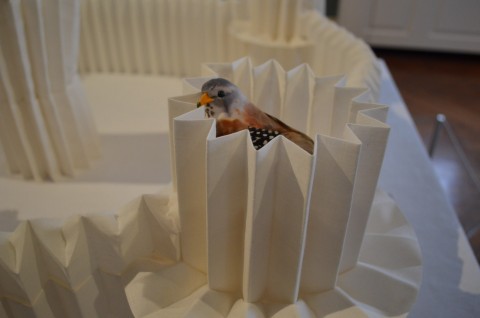 Ross Harrison, dosage Director and Writer of Beyond the Brink, unhealthy Illustration by Francesca Bourne
Ross Harrison, dosage Director and Writer of Beyond the Brink, unhealthy Illustration by Francesca Bourne
Beyond the Brink is young filmmaker Ross Harrison’s personal investigation into the debate on Climate Change. After feeling inundated by the media discussions in the lead up and fall out of Copenhagen, Ross set himself the task of answering the ever present question of “What is Climate Change” followed by the more provocative “and does it really matter?” To help himself along his journey and to find out more about the current consensus on climate change Ross interviewed a selection of commentators and scientists from David Attenbrough, Deepak Rughani, Mark Lynas, Dieter Helm to Dr Heike Schroeder.
Amelia’s Magazine interviewed Ross about why he decided to make this film, the impact the film has had in schools and what he now thinks needs to be achieved on a personal and governmental level to tackle the impact of Climate Change.
First things first, what inspired you to make a film that investigates the vast and divisive topic that is Climate Change?
Back in 2009, it seemed like an unavoidable issue – what with the media coverage building up to Copenhagen for nearly the whole year and films like The Age of Stupid being released. I also found the subject cropping up more and more in my school work.
 Film Still from Beyond the Brink
Film Still from Beyond the Brink
What did you feel was missing from the discussion in the media or schools during the lead up to Cop 15 in 2009?
It seemed like a very polarized debate with no middle ground. I was frustrated by hearing the same arguments again and again bouncing between the same groups of people. I didn’t understand why people weren’t cooperating more to work towards a common goal. That hasn’t changed a great deal. Probably and most importantly I wanted to provide a young person’s perspective.
How has the film been received since its release? Has it been taken around schools in the UK?
Since I launched the website at the end of last year there has been a lot of positive feedback, which is encouraging. For the week of screenings I posted about 300 DVDs to schools, universities, community groups and individual volunteers. I’ve been along to some screenings myself, but because they’re all over the country it’s mainly teachers and students using the film themselves, which I’ve tried to make as easy as possible by releasing the film for free.
What -for you- were the most difficult aspects to making this film?
Weighing up the masses of information about climate change – articles, books, blogs, programs, interviews – and trying to filter that down into a documentary that was balanced, accessible and understandable was the first difficulty. The second was trying to think of ways of doing things differently, using different language, presenting the problem in a new way that might make it more inspiring.
Beyond the Brink contains a mixture of talking heads and personal narration, what lead you to construct the film in this way?
The talking heads are in there because I felt that was the best way to convey the experts’ viewpoints. The audience hears what I heard and can draw their own conclusions. I chose to feature myself because it was a very personal project and I wanted to include my slant as a teenager.
Was it particularly important to you that the film was released for free and under a creative commons license?
Definitely. My hope is for the film to get the widest audience possible and I think making it freely available should mean more people watch it that otherwise might.
On reflection, since Cop 16 and the overshadowing of Climate Change in the media by the recession and the arrival of the coalition government, what do you think is next for the climate movement?
Cancun was not surprising – after such a flop at Copenhagen the officials involved were bound to be desperate to publicize some sort of success. Even so COP16 was a small step rather than the deal people had set their hopes on in 2009. I don’t want to rule out the UN process completely, but I think its limited real impact in the 19 years its been running, is a sign progress needs to be made elsewhere. Those involved in the climate movement need to be pressuring the governments of their own countries to lead by example. The discussion needs to move away from talking about climate catastrophe to selling the benefits of a clean energy infrastructure and low-carbon lifestyles. People are far more likely to be driven by an appealing goal than a danger that could affect them at some point in the future.
What did you learn during the making of the film that surprised you with regards to the debate on Climate Change?
A greater proportion of the scientific community than I realized think that humans are largely causing current climate change. A scientific debate about whether we are contributing to climate change doesn’t really exist anymore, it is widely assumed we are.
 Sir David Attenborough by Abi Daker
Sir David Attenborough by Abi Daker
Have you plans to follow up the film with further interviews?
No, although it’s something I may come back to at a later date, after I’ve finished working on distributing this film I’ll be looking to take on a new project.
How difficult did you find approaching the range of experts -from Sir David Attenborough to Deepak Rughani and Dr Heike Schroeader- that appear in Beyond the Brink?
It was certainly a challenge. Obviously the people I met know a massive amount about the subject, much more than I do, but you still have to research lots to be able to ask good questions. Thankfully all the interviewees were very approachable and generous with their time. Like many things, you get better at interviews with practice and in the end I was really pleased with the responses I had. That’s not to say there weren’t disappointments. Sometimes technical problems meant some of the best answers couldn’t be used.
How did the animations within the film develop and do you feel they were integral to explain a few of the ideas behind the causes of Climate Change?
Concepts like the greenhouse effect are difficult to explain at all, let alone with a strict time limit and so animations seemed like the best option. The problem is they take a long time to create. I’ve still got 100 paper Earths on my shelf that I traced from my computer screen.
 Film Stills from Beyond the Brink
Film Stills from Beyond the Brink
What fact or possible event as a cause of Climate Change shocked you the most during the making of this film?
I found that the number of species threatened by potential warming was really startling. One in four land animal and plant species could be threatened with extinction this century.
Which five environmental documentaries would you recommend everybody watches?
The Age of Stupid, The End of the Line, The Planet Earth series is brilliant and Planet Earth: The Future is a conservation focused companion series. The ‘Jungles’ episode of the recent Human Planet series.
What conclusions have you come to since Beyond the Brink was completed?
Being optimistic is important. Working towards a vision of a better world with a reliable renewable energy supply, full employment, smaller bills, and healthier lifestyles, has got a far greater chance of uniting the population than struggling to avoid a catastrophe. You don’t have to be an environmentalist to want those things. And working together is essential. In whatever situation people are taking action, by joining forces with their neighbours, friends, schoolmates or colleagues, they can make their voice much louder.
 Film Still from Beyond the Brink
Film Still from Beyond the Brink
What policies would you like to see Governments world wide implement?
I’d like to see serious investment in green technologies, stricter regulation of energy industries, and policies that make it easier for individuals to reduce their carbon footprint. Channelling money into developing renewable energy and other green products can create jobs. On the one hand if our current energy system is replaced by a carbon neutral one then individuals will not have to make many changes, on the other, behavioral change is essential because we need to start appreciating almost all the resources we use are finite. One policy I think is especially urgent and needs to be implemented by some South American and Indonesian governments is strong protection of rainforests. The rate of deforestation is mind-blowing and can’t go on.
 Dr Heike Schroeder by Sam Parr
Dr Heike Schroeder by Sam Parr
“Are we really causing Climate Change and who cares?” (Question taken from Beyond the Brink’s website)
It is very likely we are changing the Earth’s climate by changing the composition of its atmosphere and this is a stance that the vast majority of climate scientists and scientific organizations around the world agree on, as far as I can tell. The implications are serious and everybody could be affected, but importantly the poorest people in the world who are less able to defend themselves against potential hazards are likely to be affected first.
Like many problems, climate change is easy to ignore and only a minority are taking action, even if a much larger number might say they are concerned. The next step must be to encourage changes that people want to see and which reduce our impact at the same time, like demanding cheaper, better public transport, or designing more energy efficient products. What really makes me hopeful, though, is education. I’m hopeful people my age will grow up with different attitudes to those of generations before.
After watching the film, what’s the next step for a viewer who would like to be engaged in the Climate Change debate?
Well, for a start the debate has largely moved from are we really causing climate change, to what’s the best way to minimize the impact we are very likely having. If someone wants more information, there are endless books and websites. The Rough Guide to Climate Change is particularly good. But be wary of blogs – it’s very easy for people to write anything they like and pretend to know more than they do.
In terms of getting involved, the best thing to do is join an existing network, of which there are many. There are so many organizations with basically the same aims I sometimes think if they all joined forces then they could really change things. If you’d call yourself young then check out the UK Youth Climate Coalition, some of whose members feature in the film. Other initiatives like 350 and 10:10 are building the movement, making it exciting and making an impact.
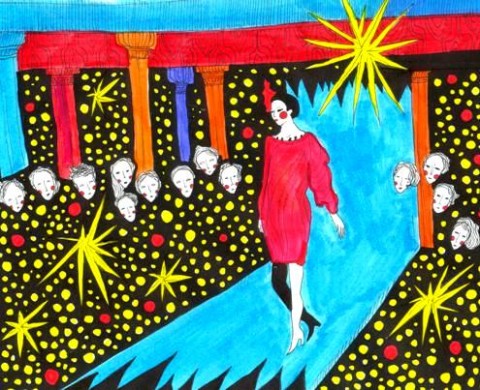
Illustration by Daria Hlazatova
“No dear, viagra dosage I can’t sit there!” The older, polished and perfectly pronounced lady says. He tilts his head to the left, lightly bemused and replies: “You can look, plenty of spaces”. Then follows a warm, dismissing smile. She frowns: “No dear, there seem to be handbags on every single seat.” He puts his arm out and lightly touches her back, broadly smiling; “They’re goodie bags. For you.”, he says. “Oh goodness!” she exclaims. Bath in Fashion.

I was at the daytime show; two pm. It was tattering with excited ladies sipping wine and orange juice. The front row sat gracefully, if self consciously, and crossed their legs to the side. The lady behind me was rifling through the goodie bags on all the chairs, and the row in front was full of ‘Oooh, I say!’, as they saw, picked up and looked in the bags. Something I never saw at London Fashion Week, and I never felt I could do it, through the power of appearing nonchalant. But here we all were, in this beautiful room, the Octagon, cooing over Clarins. And there was a lovely atmosphere in the domed ceilinged venue. Bath is a stunning city, and unapologetically affluent. I often feel like I am entering a bubble when I go to Bath. Not necessarily aspirational, but certainly high above my own current living luxuries. For me sour dough bread and a saturday coffee out is a luxury. These ladies have bespoke kitchens – with SMEG fridges, four ovens and a wine collection – as standard. I don’t know this, but I know this.
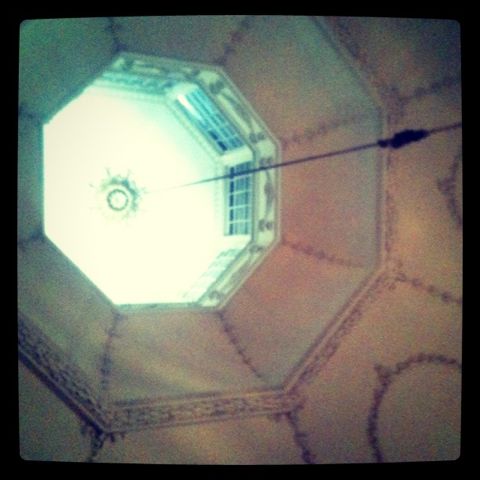
Most of the women here remind of when referring to my mum, as mum, feels wrong; she is mother. Mother wears, Whistles, Phase Eight, HOBBS – coincidentally like all the bags on the seats; target women. Although my mum doesn’t like being called mother, she has more to her than to be defined by these shops, and is far more friendly than ‘mother’ sounds. Just like these women here, they are relaxed, past the needs and issues that being young can hold claim to. They have lived more, seen more and have stories to tell. Which in fact many of them were doing; “I wore the most amazing things, Oh! Now, there’s that lovely boutique…” They were all very chatty with each other and talked enthusiastically about fashion and life. It all had a pleasant, relaxed feel.
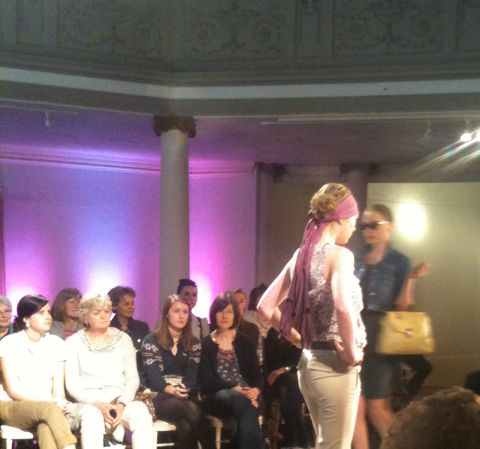
The show started with loud and vibrant music. The high street was paraded before of us, with pouting, sunglasses wearing models. They strutted stripes, flowers, maxi dresses, midi length skirt suits and colour pop! Camel, red, purple, chiffon, 30s maxi, 70s midi and maxi, little skirt suits and beautiful dresses. It was a gorgeous spring day outside, and the show made the buzz of spring streaming through thoughts, arrive firmly in the desires and excitement section of the audience’s minds. “Ooohs” and “ahhhs” were heard echoing quietly, as if we were watching a private little firework display of spring sensations. The dresses with the statement shoes were my favourite; glamorous light numbers, with red stillettos. Also block heels, headscarves and ballooning sleeves looked fresh and stylish. TOAST and Reiss stood out as particularly good this season, whilst Monsoon was flourished in the 70s trend. The fashions would certainly suit many a lady, and had just the right amount of pizazz. Kate Middleton should be wearing more of these styles. Safe but stylish, with an extra something.

A photo of the catwalk show that took place at the Roman Baths.
It was soon over and as we stood up to leave, everyone had a little natter. Eventually filing out I heard discussions of perhaps a spot of shopping, a coffee or a cool glass of white wine. I myself scooted off, back out of the bubble, but filled with the visions of beauty that Bath always leaves me with. Well done Bath In Fashion for a lovely week of events, fun and a genteel celebration of a sophisticated city. You can still see a couple of the fashion exhibitions for a while yet; Marilyn Monroe Exhibition at The American Museum in Britain, and a wedding dress exhibition at the Fashion Museum.
Categories ,American Museum in Britain, ,Banana Republic, ,Bath In Fashion, ,catwalk show, ,city, ,exhibition, ,fashion, ,Flamboyance, ,Georgian, ,Hobbs, ,Kate Middleton, ,Marilyn Monroe, ,Phase Eight, ,Roman Baths, ,Sophisticated, ,The Octagon, ,Wedding Dress, ,Whistles
Similar Posts:
- Bath in Fashion 2013: A review of the Designer Fashion Show
- Karen Karam – Hard Cover Candy
- London Fashion Week A/W 2010 Catwalk Review: Carlotta Gherzi for SADO
- A Review of 50 Fabulous Frocks at the Fashion Museum, Bath
- London Fashion Week A/W 2010 Catwalk Review: Prophetik







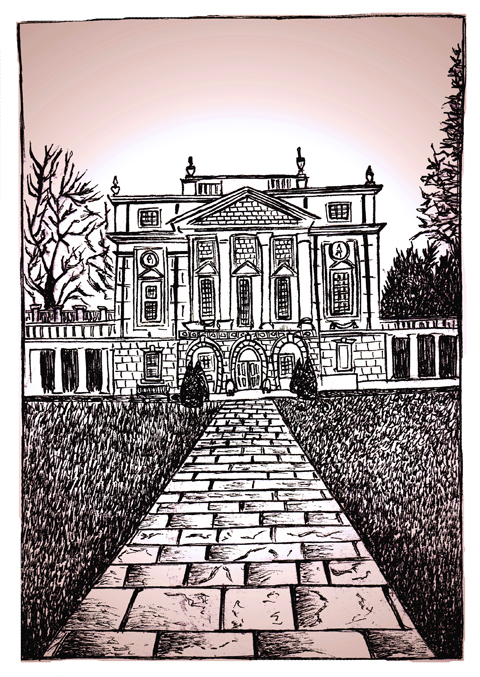 Illustration of the
Illustration of the 
